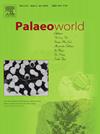Coniferous woods from the Albian (Piedra Clavada Formation) of Argentine Patagonia
IF 1.7
3区 地球科学
Q2 PALEONTOLOGY
引用次数: 0
Abstract
Five samples of silicified fossil woods were collected from the Lower Cretaceous Piedra Clavada Formation, Santa Cruz Province, Argentina. The preservation of the fossil woods varies. Two very poorly preserved specimens are classified as “indeterminate conifers”. Based on the wood anatomy of the remaining specimens, we identified two taxa: Brachyoxylon patagonicum (one specimen), possibly related to the extinct conifer family Hirmeriellaceae, and cf. Brachyoxylon/Agathoxylon (two specimens), possibly related to the Hirmeriellaceae or the Araucariaceae. All samples have distinct growth ring boundaries, indicating annual seasonality. Furthermore, the curvature of the rings and the minimum estimated diameter suggest that the woods came from mature trees. Decay patterns resembling those induced by contemporary xylophagous fungi were identified in one specimen. The presence of fossil woods possibly related to the Hirmeriellaceae and Araucariaceae in the Piedra Clavada Formation is consistent with previous palynological studies of this stratigraphic unit. These records support the dominance of conifers in the Early Cretaceous forests of Argentine Patagonia.
阿根廷巴塔哥尼亚的Albian (Piedra Clavada组)的针叶林
从阿根廷圣克鲁斯省下白垩统Piedra Clavada组采集了5个硅化木化石样本。保存化石木材的方法各不相同。两个保存非常差的标本被归类为“不确定针叶树”。根据剩余标本的木材解剖,我们鉴定出两个分类群:Brachyoxylon patagonicum(1个标本),可能与已灭绝的针叶树科Hirmeriellaceae有关;cf. Brachyoxylon/Agathoxylon(2个标本),可能与Hirmeriellaceae或Araucariaceae有关。所有样品都有明显的生长环边界,表明了年季节性。此外,年轮的曲率和最小估计直径表明,这些木材来自成熟的树木。在一个标本中发现了类似于当代木食真菌引起的腐烂模式。彼德拉克拉瓦达组中可能与Hirmeriellaceae和Araucariaceae相关的化石木的存在与该地层单元的孢粉学研究一致。这些记录支持了阿根廷巴塔哥尼亚早白垩纪森林中针叶树的优势。
本文章由计算机程序翻译,如有差异,请以英文原文为准。
求助全文
约1分钟内获得全文
求助全文
来源期刊

Palaeoworld
PALEONTOLOGY-
CiteScore
4.00
自引率
5.90%
发文量
95
期刊介绍:
Palaeoworld is a peer-reviewed quarterly journal dedicated to the study of past life and its environment. We encourage submission of original manuscripts on all aspects of palaeontology and stratigraphy, comparisons of regional and global data in time and space, and results generated by interdisciplinary investigations in related fields. Some issues will be devoted entirely to a special theme whereas others will be composed of contributed articles. Palaeoworld is dedicated to serving a broad spectrum of geoscientists and palaeobiologists as well as serving as a resource for students in fields as diverse as palaeobiology, evolutionary biology, taxonomy and phylogeny, geobiology, historical geology, and palaeoenvironment.
Palaeoworld publishes original articles in the following areas:
•Phylogeny and taxonomic studies of all fossil groups
•Biostratigraphy, chemostratigraphy, chronostratigraphy
•Palaeoecology, palaeoenvironment and global changes throughout Earth history
•Tempo and mode of biological evolution
•Biological events in Earth history (e.g., extinctions, radiations)
•Ecosystem evolution
•Geobiology and molecular palaeobiology
•Palaeontological and stratigraphic methods
•Interdisciplinary studies focusing on fossils and strata
 求助内容:
求助内容: 应助结果提醒方式:
应助结果提醒方式:


